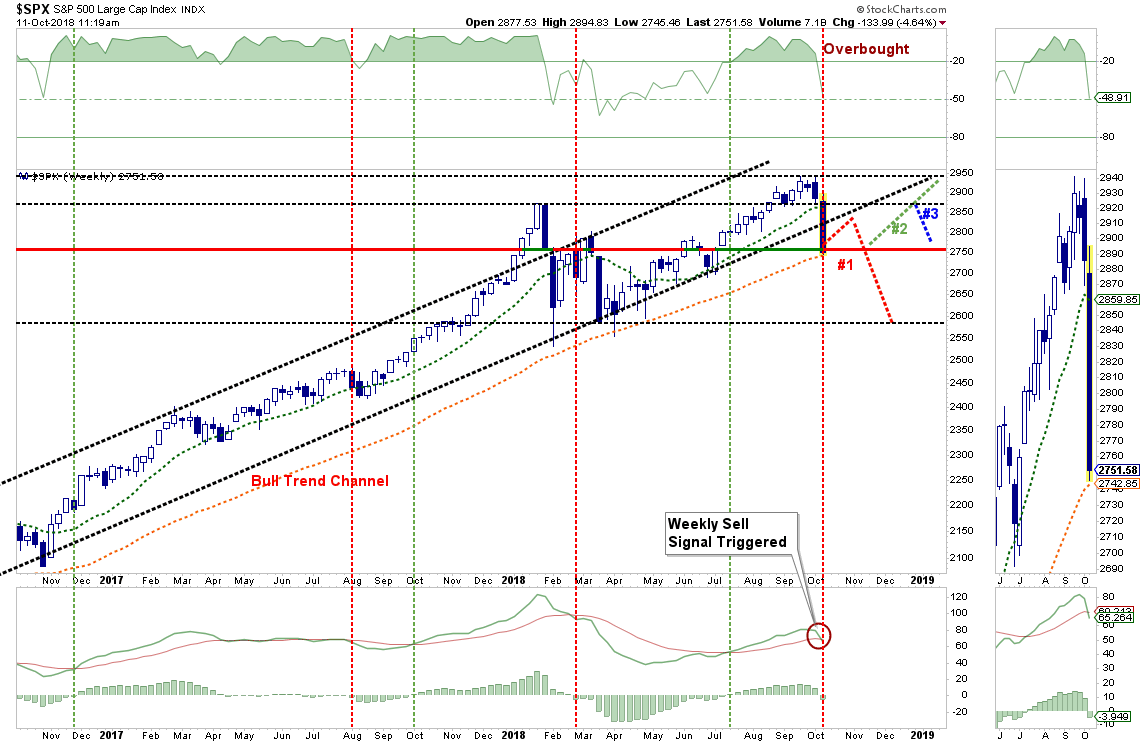This is a short update to Tuesday’s Technically Speaking post. In that post, I stated:
“In this past weekend’s newsletter, I discussed the fact the markets had finally awoken to the reality that rates have once again broken above 3%.
‘Speaking of rates, each time rates have climbed towards 3%, the market has stumbled.’”
Well, on Wednesday, the markets did indeed stumble.
As I noted, the market was testing the January breakout highs and that this was a “make or break” point. I noted the two important things we were paying attention to:
- There is a defined trendline the market has held since the April lows. (Blacked dashed line) In July, the market broke that trendline but quickly recovered. A failure to get back above that trendline on this bounce, and a failure to attain new highs, will continue what appears to be an early topping pattern.
- The momentum sell signal, which signaled a “risk off” market in early February, is very close to triggering. As shown this signal was very close to triggering in July but the market rallied strongly enough to keep that from occurring. Can it do the same this time?
I also stated:
“It will be imperative the market maintains support and musters a rally by the end of the week. Otherwise, there is a high probability the market will retest the bullish trend line from the 2016 lows. With the longer-term moving average currently running along that trend line, a break below that level changes the entire dynamic of the market to a ‘risk-off’ mode.”
I have updated the chart from Tuesday. Note the deeply oversold condition currently like we saw back in early February. These oversold conditions tend to generate a short-term rally that can be used to reduce risk into.
The break of support at the January highs triggered the “algos” to start selling, and the liquidation across markets was fast and furious. The selloff also triggered a short-term “sell signal” which suggests the markets have now moved into a “risk off” mode.
As I have often stated, the initial crack in the market will often give you an opportunity to rebalance risks in a portfolio. So, it is often never wise to make emotional sell decisions. As shown in the first chart above, the recent sell-off has exhausted much of the short-term downside risk. However, it is where the market finishes the week which is most critical.
The chart below is a WEEKLY chart going back to the 2015-2016 lows.
Currently, the market IS HOLDING support at the longer-term moving average. However, the break below the accelerated bullish trend line from the 2016 lows is very disturbing and, as noted above, this break changes our stance from a near-term bullish to near-term bearish outlook.
The next chart zooms in for a closer look at what we expect to happen and what actions we will be taking in portfolios over the days ahead.
The vertical red and green lines were very short-term buy/sell signals which show when price momentum is favorable for increasing or reducing equity-related risk. That signal is currently triggering a “sell” and suggests reducing risks in portfolios currently.
Given the short-term OVERSOLD condition of the market, we want to use rallies to rebalance risks in portfolios.
I have mapped out three possible outcomes between now and the end of the year in which we will take actions.
#1 – A rally back to the bullish trendline will be used to reduce risk (ie. raise cash) in portfolios by selling lagging positions and rebalancing risk in winning positions. Rule: sell losers and let winners run.
We fully expect an initial rally to fail as investors caught in the selloff will be looking for an opportunity to sell. However, if that selloff fails to hold support at the recent lows it will suggest a bigger corrective action is in process. We will be looking to reduce equity risk further, raise cash, evaluate portfolio allocation models.
#2– If the selloff following a failed rally holds support at the recent lows and turns up, such will suggest a rally back to either the January highs or all-time highs. NOTE: A rally back to all-time highs following a corrective pullback will again retest the underside of the bullish trend line from the 2016 lows. Such remains a “bearish” backdrop from equity risk going into 2019 where economic and earnings data is expected to slow further. We will use any rally back to those levels to reduce risk as noted in #1.
#3– If the rally from the recent lows fails at the January highs we will again use that opportunity to reduce equity risk and rebalance portfolio allocations.
I must reiterate we are not suggesting blowing out of portfolios and moving to cash. What I am suggesting is that we are taking actions to:
- Manage our exposure levels,
- Maintaining trailing stop-loss levels; and
- Reducing risk and raising some cash until “the smoke clears.”
The reason we are not becoming overly negative yet, is that the longer-term backdrop of the market does indeed remain bullish for now.
However, there is clear evidence that backdrop is becoming more bearish on both a macro-economic and earnings front. Therefore, by taking some actions now, reduces the risk of something going wrong and destroying a lot of capital very quickly.
As I have repeatedly discussed over the last several weeks, prudent portfolio management practices reduce inherent portfolio risk thereby increasing the odds of long-term success. Any rally that occurs over the next few days from the current levels will be used as a “sellable rally” to rebalance portfolios and related risk. These practices align with our most basic investment rules/philosophies as noted above.
- Sell positions that simply are not working. If they are not working in a strongly rising market, they will hurt you more when the market falls. Investment Rule: Cut losers short.
- Trim winning positions back to original portfolio weightings. This allows you to harvest profits but remain invested in positions that are working. Investment Rule: Let winners run.
- Retain cash raised from sales for opportunities to purchase investments later at a better price. Investment Rule: Sell High, Buy Low
Remember, we can ALWAYS add money back into the markets once the evidence of the continuation of a bull market is available.
Until then, we are going to err on the side of caution.




